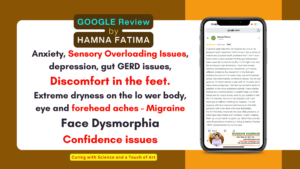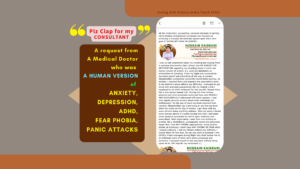Associate professor & HOD ,Department of Practice of Medicine, Faculty of Homoeopathic Science, Jayoti Vidyapeeth Women’s
University, Jaipur
PHOBIAS
A phobia is an irrational fear, a kind of anxiety
disorder in which the individual has a relentless
dread of a situation, living creature, place, or thing.
If confronted with the source of their phobia, the
person will suffer enormous distress, which can
interfere with their normal function; it can
sometimes lead to total panic. For some people,
even thinking about their phobia is immensely
distressing. A phobia starts when a person begins
organizing their lives around avoiding the object of
their fear. A phobia is much more serious than a
simple fear. People with a phobia have an
overpowering need to steer clear of anything which
triggers their anxiety
Fast facts on phobias
Here are some key points about phobias. More
detail and supporting information is in the main
article.
• Phobias are much more serious than simple
fears
• Over 50 million people in the U.S. have a phobia
• Females more commonly suffer from phobias
than males
• Despite phobic individuals being aware that
their fear is irrational, they cannot control the
feelings
• Symptoms may include sweating, chest pains,
and pins and needles
• Specific brain areas are involved in phobias
WHAT IS A PHOBIA?
If the phobia is of something that the phobic person
very rarely comes into contact with, such as snakes,
their daily lives will not be affected. However, some
complex phobias are impossible to avoid, such
as agoraphobia (fear of leaving home or being in
public places) or social phobia (fear of being among
groups of people).:
Specific phobias (simple phobias) -A
disproportionate fear about specific situations,
living creatures, places, activities, or things.
Examples include a fear of:
• Dentists (dentophobia)
• Bats (chiroptophobia)
• Dogs (cynophobia)
• Flying (aviophobia)
• Snakes (ophidiophobia)
• Birds (ornithophobia)
• Frogs (ranidaphobia)
The two examples below, social phobia and
agoraphobia, are known as complex phobias. They
are linked to a deep-rooted fear or anxiety about
certain situations, incidents, or circumstances,
which make them much more disabling than simple
phobias.Dr. Nitin Tyagi, International Journal of Medical Science and Diagnosis Research (IJMSDR)
© 2018 IJMSDR. All Rights Reserved.
2
SOCIAL PHOBIA
Social phobias are now called social anxiety
disorder. A person with social phobia finds being in
social situations difficult and sometimes
unbearable. Going to parties, weddings, functions,
or exhibitions cause sufferers anxiety; there is fear
of being embarrassed or humiliated in public.
It often includes a fear of being judged by other
people. People affected with social phobia feel that
they will be scrutinized and singled out in the
crowd; they prefer to avoid social gatherings
altogether.
Psychologists say that a high proportion of adults
with social phobia start taking measures to avoid
social situations during their teenage years. Studies
have shown that their progressively isolated
lifestyles make them more susceptible
to developing depression. Experts emphasize
that social phobia is not the same as shyness.
Obese people may develop social anxiety disorder,
simply because of their weight.
AGORAPHOBIA
An individual with agoraphobia is frightened of
finding themselves in situations where there is no
escape; they fear being stuck in a desperate
situation with no help. Agoraphobia may include a
dread of traveling on buses or trains or going into
large shops or shopping malls. When symptoms are
severe, the patient may find stepping out of their
own home unbearable.
Sufferers have an increased risk of also suffering
from panic disorder. As with social phobia, crowded
and public places are avoided.
COMMON PHOBIAS
Arachnophobia (fear of spiders) is among the top
ten phobias worldwide.
The ten most common phobias in the U.K. and U.S.
are:
• Social phobia – fear of being in places with a lot
of people
• Agoraphobia – fear of being somewhere with no
support, away from home, open spaces
• Claustrophobia – fear of being in constricted,
confined spaces
• Aerophobia – fear of flying
• Arachnophobia – fear of spiders
• Driving phobia – fear of driving a car
• Emetophobia – fear of vomiting
• Erythrophobia – fear of blushing
• Hypochondria – fear of becoming ill
• Zoophobia – fear of animals
Symptoms of phobias
The following symptoms are common across the
majority of phobias:
• When exposed to the source of the fear, there
is a sensation of uncontrollable anxiety
• A feeling that at all costs, the source of that fear
must be avoided
• The anxiety is so overwhelming when
confronted with the source of the fear, that the
person is unable to function properly
• It is common for sufferers to acknowledge that
their fears are irrational, unreasonable, and
exaggerated; however, in spite of this, they are
unable to control their feelings
• Panic and intense anxiety, which may include:
o Sweating
o Abnormal breathing (panting, trying to catch
your breath)
o Accelerated heartbeat
o Trembling
o Hot flushes or chills
o A sensation of choking
o Chest pains, chest tightness
o Butterflies in the stomach
o Pins and needles
o Dry mouth
o Confusion and disorientation
o Nausea
o Dizziness
o Headache
• A feeling of anxiety is produced by simply
thinking about the object of the phobia
• Children may cry, become very clingy, attempt
to hide behind a parent’s legs or an object, or
have tantrumsDr. Nitin Tyagi, International Journal of Medical Science and Diagnosis Research (IJMSDR)
© 2018 IJMSDR. All Rights Reserved.
3
CAUSES OF PHOBIAS
It is unusual for a phobia to start after the age of 30;
most of them begin during early childhood, teenage
years, or early adulthood. They can be caused by a
stressful situation or experience, a frightening
event, or a parent or household member who has a
phobia which the child becomes progressively
aware of.
COMMON CAUSES FOR SPECIFIC (SIMPLE)
PHOBIAS
These usually develop when the child is aged 4-8. In
some cases, it may be the result of something that
happened early in life. The trigger might have been
an unpleasant experience in a confined space,
which festered and developed into
claustrophobia over time.
As mentioned above, witnessing a family member’s
phobia is a common cause for phobias that started
during childhood. A child whose mother has
arachnophobia is much more likely to develop the
same phobia.
Experts stress that phobias picked up from parents
are learned fears – they are not genetically
inherited.
COMMON CAUSES FOR COMPLEX PHOBIAS
The causes of agoraphobia or social phobia are still
a mystery; nobody is sure exactly why they appear.
Researchers believe they are caused by a
combination of life experiences, brain chemistry,
and genetics.
Social phobias are more likely to be caused by an
extremely stressful experience than agoraphobia,
researchers say.
Phobias and survival – there may be evolutionary
explanations for many phobias. In prehistoric
environments, remaining in wide open spaces
would have increased the risk of being attacked and
eaten by a predatory animal. The instinct to stay at
home, especially for young children, aids survival.
Young children in their caves and huts would have
had to learn to avoid dangerous snakes and spiders
quickly.
Social phobia may have been a useful survival
instinct during ancient and prehistoric times. Being
among people you do not know, from perhaps
another tribe, was much more dangerous than
finding yourself among a crowd of strangers in a
shopping mall today.
NEUROBIOLOGY OF PHOBIAS
Specific areas of the brain – the amygdala in
particular – are associated with phobias.
Some areas of the brain – the prefrontal cortex,
medial prefrontal cortex, ventromedial prefrontal
cortex, and the amygdala – store and recall
dangerous or potentially deadly events.In future
occasions, if a very similar event is confronted,
those areas retrieve that same memory, causing the
body to react as if it was happening again.With
some people, the event may feel as if it is repeating
itself many times.
Some effective treatments manage to get the brain
to replace the memory and reactions with
something more rational. Phobias are irrational
phenomena – the brain overreacts to a stimulus.
Unfortunately, the brain areas that deal with fear
and stress keep retrieving the frightening event
inappropriately.
Neuroscience researchers have found that phobias
are often linked to the amygdala, which lies behind
the pituitary gland. The amygdala can trigger the
release of “fight-or-flight” hormones, which put the
body and mind in a highly alert and stressed state.
TESTS AND DIAGNOSIS OF PHOBIAS
When diagnosing a phobia, a doctor will aim to
determine whether or not an object triggers
unreasonable fear. People with a phobia are nearly
always aware that it is present, and they are not
defensive when discussing their symptoms with a
doctor. This helps diagnosis enormously. Even so,
millions of sufferers never discuss their fears with a
doctor. This is unfortunate because there are
effective treatments available.
TREATING PHOBIAS
If the phobia does not cause severe problems, most
patients find that by simply avoiding the source of
their fear is enough to stay in control. Some phobias
are not possible to avoid, as may be the case with
aviophobia (fear of flying). In such cases,
professional help should be sought. The good news
is that with proper treatment, most phobias can be
cured. Treatment needs to be tailored to the
patient for it to work – no single treatment worksDr. Nitin Tyagi, International Journal of Medical Science and Diagnosis Research (IJMSDR)
© 2018 IJMSDR. All Rights Reserved.
4
for everybody. The doctor, psychiatrist, and/or
psychologist may recommend behavior therapy,
medications, or a combination of both. Therapy is
aimed at reducing the symptoms of fear and
anxiety, and to help patients manage their reactions
to the source of their fear.
Medications
The following medications have been shown to be
effective for the treatment of phobias:
Beta blockers can help reduce some symptoms of
phobias.
Beta blockers – can help reduce the symptoms of
palpitations, as well as trembling limbs. Many
patients comment that they also help their voice
quiver less.Side effects may include stomach
upsets, fatigue, problems sleeping, and cold fingers.
Antidepressants – SSRI’s (serotonin reuptake
inhibitors) are commonly prescribed for people with
phobias. They affect serotonin levels in the brain,
which results in better moods.SSRIs may initially
cause nausea, sleeping problems, and headaches.
A tricyclic antidepressant (TCA), such as
clomipramine (Anafranil) has also been found to
help phobia symptoms. Initial side effects can
include sleepiness, blurred vision, constipation,
urination difficulties, irregular heartbeat, dry
mouth, and tremors.If the SSRI does not work, the
doctor may prescribe a monoamine oxidase
inhibitor (MAOI) for social phobia, an example is
moclobemide (Manerix). Patients on an MAOI may
have to avoid certain types of food. Side effects
initially might include dizziness, stomach upsets,
restlessness, headaches, and problems sleeping.
Tranquilizers (sedatives) – benzodiazepines may
help reduce anxiety symptoms. Patients with a
history of alcoholism should not be given sedatives.
Behavior therapy
Desensitization (exposure therapy) – if done
properly, this can help patients alter their response
to the source of their fear. Patients are exposed to
the cause of their phobia in gradual progressive
steps. Somebody who is afraid of flying on a plane
may start off just by thinking about flying, then
looking at planes, going to an airport, perhaps
sitting in a practice simulated airplane cabin, and
then finally getting on a plane.
Cognitive behavioral therapy – the therapist helps
the sufferer learn different ways of perceiving the
source of their phobia, so that they may find it
easier to cope. Alternative views about the fear(s)
are taught. The patient is taught about the impact a
wrong approach may have on quality of life, and
how a new one may change things. Most
importantly, those with phobias learn to become
masters of their own feelings and thoughts
HOMEOPATHIC MEDICINES
Aconite: Best Homeopathic medicine for anxiety
with fear of death. Natural Homeopathic
medicine Aconite is the top homeopathic
medicine for anxiety. It is of great help
particularly for those having anxiety of death.
Cases of extreme anxiety with a strong emotion
of fear have been successfully treated with
Aconite. It is of great help for patients who are
even afraid of venturing out of the house or fear
going to the doctors.
Arsenic Album: One of the Top Homeopathic
medicines for anxiety with restlessness Arsenic
Album, like Aconite, is among the best natural
Homeopathic medicines for anxiety. It is very
beneficial as a remedy if a patient suffers from
anxiety with marked restlessness. The person
needing Arsenic Album has intense anxiety
about his own future and health, and also for
others. This Homeopathic remedy is of great
help for treating anxiety that is marked by great
despair, driving the person to move from one
place to another. Arsenic Album also provides a
very beneficial cure for people who fear being
left alone. If there is a strong fear of disease or
of financial loss, Arsenic Album is the best
natural Homeopathic remedy.
Argentum Nitricum:
One of the Best natural Homeopathic medicines
for anxiety from anticipation Homeopathic
medicine Argentum Nitricum is of great help in
the treatment of anxiety from anticipation —
when a person is anxious and his mind is filled
with apprehension and fears. The one clear
symptom for prescribing Homeopathic medicine
Argentum Metallicum is anxiety with mental
impulses. The person walks rapidly. Argentum
is one of the best homeopathic medicines for
anxiety when it comes to homeopathic treatmentDr. Nitin Tyagi, International Journal of Medical Science and Diagnosis Research (IJMSDR)
© 2018 IJMSDR. All Rights Reserved.
5
of performance anxiety. In such cases, the
person thinks that all his undertakings will fail.
Gelsemium:
One of the Top Homeopathic medicines for
anxiety when appearing in publicThe best
natural Homeopathic medicine for treatment of
anxiety especially when appearing in public is
Gelsemium. Fear also accompanies anxiety in
such situations. Stage fright with symptoms of
anxiety is also best treated with Homeopathic
medicine Gelsemium. A distinguishable
symptom is nervousness with trembling of
hands. The person also feels anxious about his
present, future and health. Gelsemium is also of
great help in dealing with anxiety during
examination.
Kali Arsenicosum:
One of the Best Homeopathic medicines for
anxiety about health Kali Arsenicosum is one of
the top Homeopathic medicines for anxiety
when the anxiety is relating to health. This
natural remedy is of great help for persons who
are always anxious and restless about being
afflicted with a life-threatening disease, or
having a stroke. Homeopathic medicine Kali
Arsenicosum is also very beneficial for treating
mental and physical restlessness with fear that
something bad will happen. Anxiety on going to
bed with difficult breathing is best treated with
natural Homeopathic medicine Kali
Arsenicosum.
References:
1. www.hpathy.com
2. http://www.homeoint.org/books/boericmm/index.htm
3. http://homeoint.org/books/allkeyn/index.htm
4. Ahuja Niraj, A short textbook of psychiatry.
5. https://www.medicalnewstoday.com/articles/2
49347.php








A Very good article on Phobia and fear